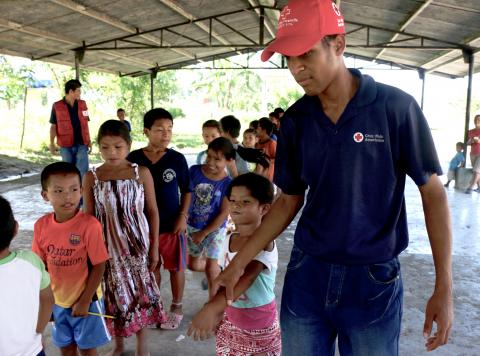The Pillowcase Project Prepares Students for Disasters
In the aftermath of Hurricane Katrina, the Southeast Louisiana Chapter of the American Red Cross began an effort to educate youth residing in temporary housing communities about emergency preparedness through a fun, artistic activity: decorating pillowcases to hold emergency supplies kits. Chapter Executive, Kay Wilkins, was originally inspired to use pillowcases after hearing about local college students who carried their belongings inside pillowcases when they evacuated during the storm in 2005. Soon after, what began as a simple project to teach kids about preparedness using art therapy for one chapter, quickly evolved into a preparedness education program that was expanded throughout all of Louisiana.
The Pillowcase Project has continued to gain notoriety and has been shared nationally across Red Cross chapters seeking to build their own youth preparedness programs. For each chapter, the project is modified and adapted to fit the community’s local needs but still utilizes evidence-based curriculum tools that all chapters can use. Standardizing the Pillowcase Project across regions is part of a larger Red Cross effort to standardize its overall disaster preparedness education. With support and funding from The Walt Disney Company, the Pillowcase Project is currently enrolled in a three-year plan to standardize and pilot test the program as it completes a national roll-out.
Phase 1: Design and Development of a National Program
During Phase 1 of this program, 19 Red Cross chapters participated in a pilot test of the newly standardized program and reached 3,348 3rd grade students with 105 Pillowcase Project presentations, materials, and pillowcases. The majority of these presentations (92%) were conducted in a traditional classroom setting, while the rest were conducted in a variety of non-school settings, such as community centers or after-school programs. Pilot chapters prioritized reaching specific populations with their presentations and classified its scope based primarily on information provided by the site.
The presentation curriculum focuses on several important learning methodologies for 3rd-5th graders, including peer to peer and experiential learning. The “practice” activities in each section allow students to engage in an activity—either a protective action or a coping skill—by actually practicing it during the presentation. The “sharing” activities enable peer to peer and group learning by facilitating a discussion for students and their peers about the topic. These components help presenters keep students’ attention throughout the 60 minute presentation and provide more meaningful learning experiences than simply listening to a presenter talk.
Students also receive a workbook that helps them reference different topics during the presentation and learn more about preparedness after the program ends. The student’s ‘My Preparedness Workbook’ is a robust 28-page resource for students that include tools to help them engage their families and friends in taking important preparedness actions alongside them. The workbook culminates with a story and activity page to reinforce preparedness skills and a final page is given to encourage students to reflect upon what they’ve learned and completed.
Curriculum: Local Hazard
To test the curriculum, pilot programs presented on a variety of local hazards to students and used pre- and post-assessments to quantify success and inform curriculum development for Phase 2. Students’ assessments showed an increase in knowledge about hazard-specific information and protective action taught for all hazards except tornadoes. Based on pre-assessment scores, students’ base knowledge of the hazard was already high, thus the margin of possible improvement was relatively small. However to improve its curriculum the project partnered with the National Oceanic and Atmospheric Administration (NOAA) and other experts to make information on tornadoes more clear and accurate for presenters to teach.
Curriculum: Coping Skills
The innovative Coping Skills portion of the curriculum was extremely successful, both with students and chapter staff and presenters. Presenters felt empowered to teach students a skill beyond the basic preparedness information they usually shared, and students responded well to learning new concepts around “resiliency” and “coping.” Two highlighted activities in this section are the ‘Breathing with Color’ and ‘Symbol of Strength’ activities. The ‘Breathing with Color’ activity has been used for decades by Red Cross disaster responders in post-disaster situations and shelters to teach younger children how to use deep breathing to calm themselves. The ‘Symbol of Strength’ activity on the other hand was created specifically for The Pillowcase Project by Red Cross Disaster Mental Health professionals. It is an exercise that teaches students to visualize an intangible concept—their own personal strength—and empowers them to use that image as a confidence-boosting mechanism in times of need.
Phase 2: Expanded Testing
Sixty Red Cross regions will be pilot testing the Pillowcase Project throughout March 1, 2014 and March 1, 2015. Together, they anticipate reaching 200,000 3rd-5th graders across the United States. The curriculum and materials they will use have been modified based on initial lessons learned from Phase 1. Additional adaptations will be made after Phase 2 ends and before the beginning of the final phase of the 3-year development and testing program.
Lessons Learned :
- Providing students with a Disney branded pillowcase that highlights recognizable figures to excite students and encourage them to value the pillowcase.
- Emphasizing both “practice” and “sharing” activities in the Local Hazard section to teach students both a physical protective action and to touch on real life scenarios related to fear or anxiety that students may face.
- Emphasizing the flexibility of the program to implement in not only schools but also community centers, troop meetings, YMCAs and Boys & Girls Clubs.
- Encouraging chapters to work with a wide variety of staff and volunteers, including Youth Club volunteers, Disaster Mental Health workers, and former educators to add variety and depth to the implementation.
Supporting Materials :



